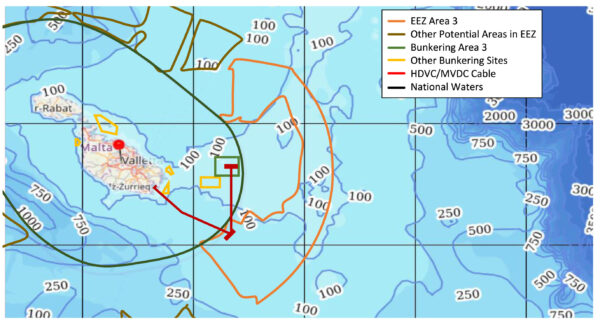A Maltese-Chinese research group is proposing the development of an offshore mooring and power platform (OMPP) run by PV, wind, and energy storage in Malta's national waters.
The proposed virtual power plant (VPP) integrates a platform-to-ship (P2S) setup to electrify anchored and bunkering ships, providing surplus electricity to the country's grid. Numerical calculations were conducted, along with site selection methodologies, to size the system and prove its feasibility.
“A key technology to sustainable practices in the maritime industries is shore-to-ship (S2S), which allows ships to turn off these diesel engines by drawing power from the shore's electricity grid,” the team explained. “Very large floating structures (VLFS) platforms, with their stability and load-bearing capacity in open waters, are particularly well-suited to host S2S systems, resulting in P2S capabilities that offer a sustainable energy solution for vessels at sea, including hybrid and electric ships.”
According to the researchers, Malta's strategic position in the Mediterranean as a key maritime hub makes it an ideal location for deploying the OMPP. Based on the country's National Policy for the Deployment of Offshore Renewable Energy, the academics have identified a specific area, called Area 3 – as suitable for offshore PV and wind farms and storage, as it has relatively shallow offshore characteristics and is one of six designated bunkering areas off Malta's coast.
“The OMPP connects to the offshore VPP via a medium voltage direct current (MVDC) link, approximately 20 km long. The platform, with estimated dimensions of 1,200 × 300 m, is designed to accommodate up to four ships, each up to 200 m long,” the group added. “It features a 24 MVA P2S facility with four berths, each providing up to 6 MVA. The platform dimensions are based on a 20 m buffer zone on each side of the ships, allowing four ships to dock comfortably with a safety margin for operational flexibility.”

Image: University of Malta, Ocean Engineering, CC BY 4.0
Following the numerical simulation and using weather data, the scientists found that the system would demand a 200 MW floating wind farm and a 300 MW floating PV farm to support the demand of the ships and export energy to the island's grid. For their analysis, they assumed the use of Maxeon's 3 SPR-MAX3-430 modules with 430 W power and 22.7% efficiency, installed with a horizontal orientation. The simulation used the SG 8.0–167 DD wind turbine, with 6.04 GWh/km2 in 2023 for the maximum wind direction.
“A detailed sizing analysis of the offshore battery energy storage system and subsea compressed air energy storage was conducted to optimize the energy storage capacity and ensure seamless power supply,” the researchers said. “The analysis revealed that a battery energy storage systems (BESS) capacity of 390 MWh is necessary to meet the short-term demands, while the compressed air energy storage (CAES) system, with a capacity of 1,260 MWh, provides additional energy security during prolonged periods of low renewable generation.”
Concluding their research, the team said that the proposed system configuration ensures that the OMPP can maintain a reliable power supply to the berths under varying operational conditions. “The simulation-based assessments confirmed the technical viability of the OMPP, though the study also identified several economic and technical challenges that still need to be addressed,” they stated. “Future work should focus on optimizing the cost structure, possibly through modular designs or alternative financing models, to enhance the economic attractiveness of such systems.”
The proposed system was presented in “Renewable energy systems in offshore platforms for sustainable maritime operations,” published in Ocean Engineering. The study was conducted by researchers from Malta's University of Malta and China's Tiangong University.
This content is protected by copyright and may not be reused. If you want to cooperate with us and would like to reuse some of our content, please contact: editors@pv-magazine.com.



Building the underwater portion as wildlife habitat would be a valuable synergy and wave generation can reduce the impact of waves on your structures.